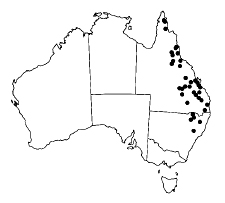

 |
 |
|
Hovea longipes Benth., in S. F. L. Endlicher et al., Enum. Pl. 37 (1837); Benth., Fl. Austral. 2: 174 (1864)
Type: Nov. Hollandia, F. Bauer 1047; holo: W.
Hovea leiocarpa Benth., in T. L. Mitchell, J. Exped. Trop. Australia 289 (1848). Type: Australia Subtropica, 1846, T. L. Mitchell 271; W.
Shrub or tree up to 5 m tall. Indumentum of branchlets, petiole, stipules, pedicel, abaxial surfaces of bract and bracteoles and external surface of calyx dense, yellow, tan or grey, hairs biramate, appressed; red glandular structures conspicuous around axils of leaves, bract and bracteoles. Leaves: petiole 2–5 mm long; lamina narrow-elliptic, lanceolate or oblanceolate, 1.5–5 cm long, 5–20 mm wide, a proportion of much smaller leaves 0.5–1.0 cm long often also present, flat to weakly arched each side of a shallowly recessed midrib, base rounded to acute, margins flat to recurved, apex emarginate, truncate or rounded to acuminate, mucro up to 0.5 mm long; upper surface green, dull to subglossy, ± smooth, glabrous or with appressed hairs along and adjacent to midrib, secondary veins numerous and all angled forward at 40–50° to midrib; lower surface including midrib completely obscured by a yellow indumentum ageing to grey, hairs appressed. Stipules absent. Inflorescences sessile or on peduncle to 4 mm long, longer if auxotelic growth has occurred, mostly 2- or 3-flowered. Flowers: pedicel 3–10 mm long; bract inserted at base of pedicel, narrow-oblong, 0.5–1 mm long, widely separated from bracteole; bracteoles inserted at or slightly proximal to base of calyx, narrow-oblong, 0.5–1 mm long. Calyx 3.2–4.5 mm long; tube 2.5–3.5 mm long; upper lip 3–4 mm wide at base, apex of lobes ± truncate, intervening sinus minute to 0.5 mm deep; lower lip 3–4 mm wide across base, lateral and lower lobes 0.5–1 mm long. Standard 5–10 mm long, 5–11 mm wide, claw 1.5–2 mm long, limb deep indigo-blue, flare white, c. 2 mm wide; wing 6–8 mm long, 2–3 mm wide, claw 1–2 mm long; keel 5–6 mm long, c. 2 mm wide, claw 1–2 mm long; style glabrous. Pod irregularly orbicular in profile, slightly angular on upper margin, 10–15 mm long, 10–15 mm deep, stipitate, stipe 3–5 mm long, external and internal surfaces glabrous. Seeds ovate-elliptic, c. 6 mm long, 5 mm wide, moderately compressed, tan, aril circular, less than 1 mm diam., c. 10% of the curved length of seed. (see Image 1)
Flowers in March–September. Fruit matures in June–December.
 Distribution
and Habitat
Distribution
and HabitatOccurs over much of eastern Queensland from Kennedy Hill north of Iron Range National Park on Cape York Peninsula south to the Queensland–NSW border, and in north-eastern NSW south to Lake Glenbawn near Scone. Grows in sands and loams derived from sandstone, basalts and serpentinite in rainforest, scrub and woodland (see map).
Hovea longipes is very different from other eastern species and
perhaps would be better placed in its own genus. The main differences
are evident in calyx, pod and seed morphology, leaf venation pattern,
indumentum type, and in the absence of stipules. The appressed biramate
hairs of H. longipes are possibly homologous with those found in
Western Australian species of Hovea.
[Source: Ian R. Thompson, "Morphometric Analysis and Revision of Eastern Australian Hovea (Brongniartieae–Fabaceae)", Australian Systematic Botany 14(1): 1-99 (2001)]